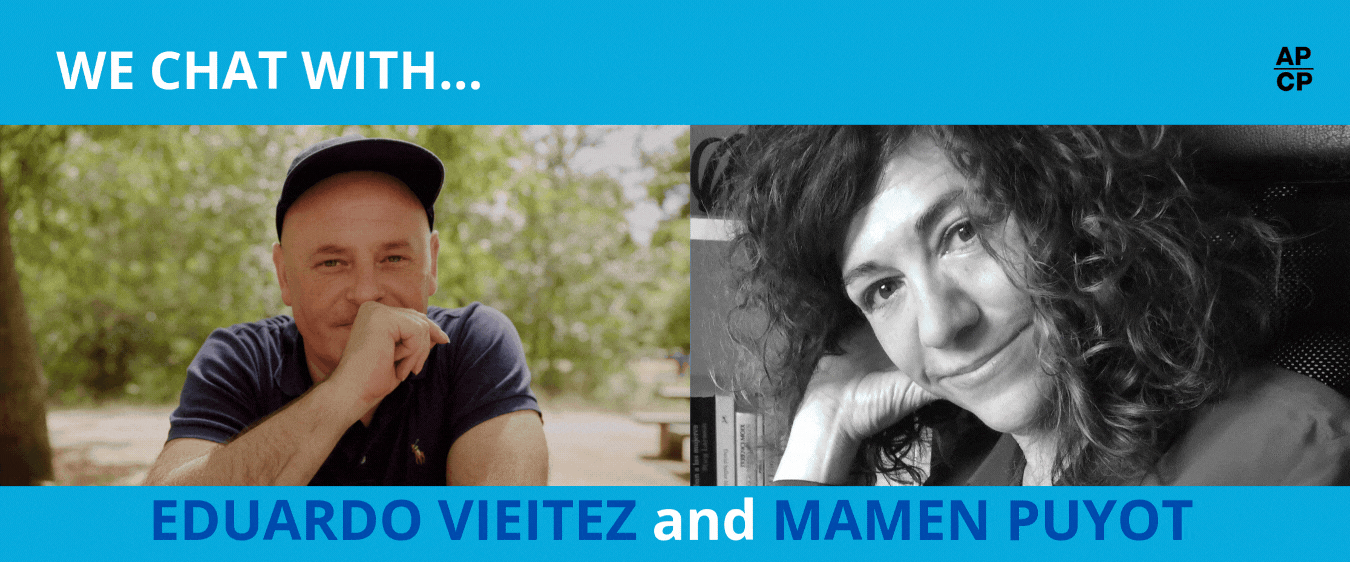
Creast is an environmental consultancy specializing in the audiovisual industry that seeks to reduce the carbon footprint produced by the sector’s activities.
The company defines itself as “the definitive solution to manage the sustainability of film, TV, advertising, event productions, film distribution campaigns, exhibition halls, and other entertainment activities.”
Creast is established as a sponsor of the APCP, collaborating in our events and helping us measure, reduce, and compensate for our carbon footprint.
Today we talk with Eduardo Vieitez, CEO; and Mamen Puyot, head of advertising of Creast about the company, sustainability… and the future.
- For those who do not know Creast, how would you describe the essence and purpose of the company in a few words?
Creast is a technology company that helps companies and professionals in the advertising sector to calculate and reduce their environmental impact.
- In which markets and sectors have you specialized? What type of clients do you usually collaborate with?
A team of professionals dedicated to advertising created Creast. We started working on sustainability management in our sector, and today we integrate several areas, all within the entertainment industry. Advertising, cinema, distribution campaigns, exhibition halls, television, cultural, musical, sports, or any other type of events that bring us together. We collaborate with the APCP and its associates, with advertising agencies, and with major advertising brands. Movistar +, Amazon Prime Video, or Disney +, among other content platforms. We have been working for 4 years with Los Premios Goya or the San Sebastian Film Festival, studios such as La Ciudad de la Luz, among others.
- Could you share some of the most outstanding projects you have worked on recently? Any success story that well represents Creast’s capabilities.
Each project has represented a challenge, adapting to its resources and specific needs, which implies providing solutions in a creative and effective way. With each one, we continue learning, improving, adapting to the needs, which has given us the opportunity to develop innovative solutions like the one we present today. We have worked with most of the major advertisers, agencies, and production companies. All projects and clients are equally important to Creast.
- How does Creast intervene in productions and what is the work process? What happens once the generated impact has been measured?
Reduce, measure, and compensate. These are the three phases of the process.
To Reduce effectively, our intervention is advisable from the moment the creativity is approved to make a sustainability plan appropriate to each project, which accompanies the creativity and the briefing that is shared with the production companies to compete. In this way, production companies can take into account the measures they can apply and include them in their production design.
From the moment the production starts, we accompany the production company throughout the process to make the extra burden of sustainability management more bearable, we contribute by finding solutions and resolving needs.
For the Measurement, we help to collect the data for the calculation of the environmental impact and the estimation of the emissions avoided thanks to the good practices implemented.
Once we receive the documentation and information that the production company provides us, we carry out the measurement, prepare a sustainability report documenting the entire process with all the information that our clients require, in accordance with the demands of high standards in calculation and reporting, such as ISO standards.
We manage the Compensation of the emissions that we cannot avoid, through a compensation program with guarantees, for example, by reforesting.
- What are the points that should be taken into account to promote responsible and sustainable production?
It depends a lot on each project, creativity, and approach of the production company. But generally, we have to try to reduce the mobility of the entire team as much as possible and choose efficient means of transport. Transport is the main source of emissions in a shoot. We can opt for local professionals so as not to move them from other regions, prioritize the train over the plane in long-distance travel, plan the occupation of all the seats in the vehicles to reduce the number of vehicles needed to move the team, or take into account the distance between locations as another criterion for their selection.
Another source of emissions that we can mitigate is energy, opting for renewable energies when we shoot on a set or when choosing the post-production studio, or when moving generator sets to real locations, trying to reduce the consumption of fossil fuels through energy accumulators, even if it is only support when its power is not enough to supply the shoot.
If we guarantee healthy catering made with local and seasonal products, proper waste management, rent art or clothing materials rather than buy them, donate everything that cannot be kept for later reuse, or efficiently manage water consumption, we contribute to improving sustainability.
- Sustainability is, increasingly, a key focus in audiovisual production, even creating specialized figures within the filming staff who are in charge of this matter. What competitive advantage does Creast offer in this regard? What is your hallmark?
At Creast we believe in the culture of the production company, each production company has its own hallmark, it is like a family with its own customs, which influence the artistic result. This identity must be preserved. Sustainability has to be generated from within the production company, it cannot be imposed from the outside. Just as each production company has its executive producers, its directors, works with certain production managers, or collaborates with certain directors of photography, it must train people from the house in sustainability management or have its “pool” of trusted eco-managers, developing its own style in sustainability management according to the identity of the production company.
In that sense, we can help by training profiles, developing corporate sustainability manuals adapting sustainability to each production company, presenting eco-managers, helping the eco-manager throughout the production process, suggesting solutions and good practices, and above all we help by providing software so that they can rigorously calculate the environmental impact, the reduction of emissions, and prepare sustainability reports that meet the demands of the client and the regulations, reducing the effort dedicated by the production company to this bureaucratic process.
Technology is our differentiation, the development of our own software is our hallmark. We do the accompaniment to help production companies improve their sustainability, but we are convinced that soon they will manage this aspect on their own like any other within the production activity.
- The advertising and audiovisual landscape is evolving rapidly with artificial intelligence and new technologies. How is Creast adapting to these changes?
At Creast, we have been developing our calculation and reporting software for 4 years. As soon as the opportunity opened up to explore the field of artificial intelligence to incorporate it into our processes, we dedicated ourselves to it with determination.
We can say that we have found a “good” use of artificial intelligence, which does not generate controversy.
Creast uses artificial intelligence to automatically extract information from production documents, scripts, shooting orders, transport orders, invoices, inventories, etc. and translate them into sustainability indicators without any person intervening in this process.
Thanks to this new appearance of artificial intelligence, our Basic product emerges.
- Tell us a little more about this initiative, BASIC. How is it born and where is it going?
At Creast we are continuously working with production companies and we observed with frustration the discomfort that the implementation of sustainability entails in the production workflows. Despite there being a clear will to improve the sustainability of their activity, it is unfair that with increasingly tight timings and budgets, production companies assume the responsibility of managing sustainability without help. In the end, it is time they dedicate to correctly managing waste, materials, optimizing the transport of teams, or collecting data and it translates into an unexpected expense.
With the emergence of artificial intelligence we decided to develop for a year a very simple and low-cost solution only for production companies, since they do not need the complex reports that end clients or advertising agencies require from us.
This initiative consists of production companies being able to comply with all regulatory requirements in terms of sustainability by simply importing certain documents into Creast, such as shooting and transport orders or invoices for goods acquired (purchase and rental of goods by art, wardrobe, etc. teams), for example. Our software and artificial intelligence do the rest of the work. With minimal effort, maximum rigor is achieved in the calculation of environmental indicators, since all results are verifiable with the ISO standard, as the new CSRD regulations require.
- Do you think clients and brands are really committed to sustainability or is it still another branding element? What does the market demand in terms of responsible production?
Increasingly, there are more advertisers committed to sustainability, not only of their own company but of all the work they generate.
Many assume a base commitment by principle and by business strategy. Also because consumer loyalty is important and to meet the expectations of society, because it continues to be one of the biggest social concerns today.
We are currently experiencing how sustainability regulations are starting to affect them and how the control over green washing is beginning to be regulated, increasing pressure on companies to be transparent in their practices and communication.
Big brands are driving initiatives to help suppliers comply with the regulatory framework relating to sustainability, through training programs, for example.
The market demands maximum transparency from companies, greater responsibility not only environmental but also social and ethical.
- From your perspective, where is the audiovisual industry heading in the next five years with regard to sustainability and how will production be transformed?
We come from shooting advertising for many years. We love good advertising, we appreciate good creative ideas, we enjoy good execution. Part of our mission is to preserve talent and art, implement sustainability in productions.



